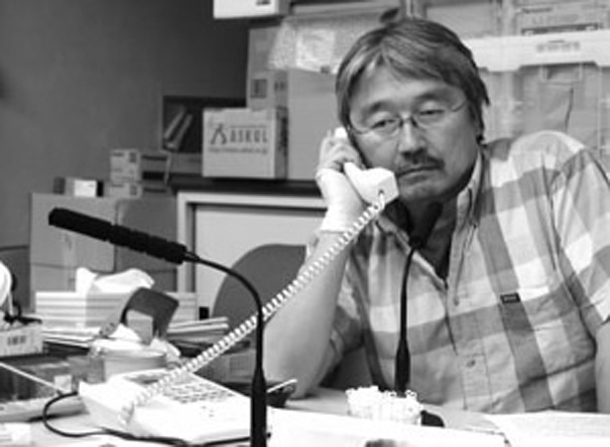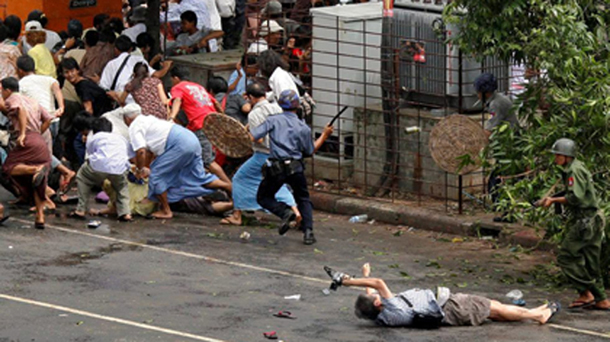RANGOON — Ko Ko Aung cannot forget the day six years ago when he spoke to his friend and colleague Kenji Nagai for the last time.
“It was around 11.30 Rangoon time when he called,” recalls the former Japan-based Burmese exile. It was Sept. 27, 2007. It was to be the last time the Japanese cameraman called his editors at the APF News office, where Ko Ko Aung was working at the time.
Later that afternoon, Kenji Nagai was shot dead in downtown Rangoon while filming an army crackdown on protests against military rule, demonstrations that were becoming known worldwide as “the Saffron Revolution.”
With foreign media banned from Burma and local press heavily-censored, Kenji Nagai’s images of the crackdown were one of the few on-the-ground sources of information on what was happening as the army moved to crush the nationwide monk-led protests.
Kenji Nagai’s bravery and dedication, which took him to Afghanistan and Iraq before his final, fatal assignment in Burma, were traits that made the 50 year old a target for the Burmese military, Ko Ko Aung believes.
As for who shot Kenji Nagai, and what became of his camera, there have been no clear answers from the Burma Government in the intervening six years. Was he shot at close quarters as many initially thought? Was it a sniper shot, as Ko Ko Aung now believes? Was he hit by ground-level gunfire by soldiers down the street? Was he killed by accident or was he targeted?
Yan Naing, a video reporter for the then-banned exile media group Democratic Voice of Burma, was filming around the area where Kenji Nagai was shot six years ago. “A soldier standing beside Kenji Nagai fatally shot him,” he told The Irrawaddy.
Ye Htut, now Deputy Information Minister and spokesman for the President’s Office, says that Kenji Nagai’s death took place under the previous military government and therefore he could not comment directly on issues such as the fate of Kenji Nagai’s camera.
“As far as we know, when the body was found, the camera was already missing,” he told The Irrawaddy
Toru Yamaji, a representative of APF News, the agency for which Kenji Nagai was filing footage from Burma’s 2007 upheavals, says that the circumstances of Nagai’s death have not been cleared-up. Even Burma’s transition to a more open form of government has not helped, the APF spokesman says.
“Burma has changed greatly, but our time has stopped since six years ago. I feel sad,” he said.

Kenji Nagai’s case became something of a cause celebre among Burma’s long-oppressed media.
Eaint Khaine Oo, a Burmese journalist and winner of the inaugural Kenji Nagai Award, established in 2009 to remember the murdered photojournalist, says that her country’s government has an obligation to return Kenji Nagai’s missing camera.
“The government did not live up to its responsibility to give back the camera,” said the reporter, who was jailed by the military junta for her coverage of the 2008 Cyclone Nargis.
Relations between Japan and Burma turned frosty in the aftermath of the killing, with the Japanese halting aid and seeking an explanation for the shooting as well as the return of Kenji Nagai’s camera, which disappeared, presumed stolen, sometime after he was shot.
But now Japan is seeking a lead role in Burma’s economic makeover – writing off almost US$2 billion of Naypyidaw’s debt and pledging loans for large-scale infrastructure projects — such as a 2,400 hectare Thilawa industrial zone planned outside Rangoon — that will perhaps support the building of Japanese factories in the low-wage country.
Some observers believe these developments have influenced Japan’s position on the case of Nagai’s death.
Shawn Crispin, Southeast Asia representative for the Committee to Protect Journalists, told The Irrawaddy that “it seems increasingly obvious that Japan does not want Nagai’s case to undermine building strong commercial ties with the new, market-opening government.”
By time of writing, the Japanese Embassy in Rangoon had not returned several calls made and an email sent asking about the Kenji Nagai case.
Such apparent indifference rankles those who knew the dead cameraman. Asked for his take on the Japanese government’s approach to finding out who killed Kenji Nagai and what became of his camera, Toru Yamaji said that “The Japanese government does nothing.”
Kenji Nagai’s elderly parents both died this year, leaving one sister as the sole surviving family member.
Toru Yamaji says that “his parents wanted the revelations of the case. It is very sad.”
Asked her thoughts on her brother’s death, six years on, Kenji Nagai’s sister Noriko Ogawa told The Irrawaddy that “I hope for the return of his camera and the resolution of his case.”
Sanay Lin and Myat Su Mon contributed reporting















